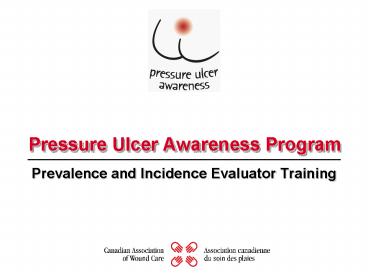Pressure Ulcer Awareness Program - PowerPoint PPT Presentation
1 / 16
Title:
Pressure Ulcer Awareness Program
Description:
Pressure Ulcer Awareness Program Prevalence and Incidence Evaluator Training Pressure Ulcer Definition A pressure ulcer is localized injury to the skin and/or ... – PowerPoint PPT presentation
Number of Views:119
Avg rating:3.0/5.0
Title: Pressure Ulcer Awareness Program
1
Pressure Ulcer Awareness Program
- Prevalence and Incidence Evaluator Training
2
Pressure Ulcer Definition
- A pressure ulcer is localized injury to the skin
and/or underlying tissue, usually over a bony
prominence, as a result of pressure, or pressure
in combination with shear and/or friction. - A number of contributing or confounding factors
are also associated with pressure ulcers the
significance of these factors is yet to be
elucidated. (NPUAP, 2007)
3
Tips
- A pressure ulcer is an ulcer related to some form
of pressure and should not be confused with
ulcers relating to disease (like cancer),
vascular flow (venous or arterial) or neuropathy
(like in persons with diabetes) - You should be able to see a cause and effect
relating to pressure with the ulcer. - Redness or discoloration over a bony area related
to sitting or lying - Redness or discoloration on the skin related to
pressure from a device such as a brace or a
wheelchair pedal
4
Not all ulcers are pressure ulcers
Neuropathic diabetic foot ulcer
Pressure ulcer to heel
Arterial ulcer on toes and forefoot
Venous leg ulcer
5
Deep Tissue Injury (DTI)
- Description Purple or maroon localized area of
discolored intact skin or blood-filled blister
due to damage of underlying soft tissue from
pressure and/or shear. The area may be preceded
by tissue that is painful, firm, mushy, boggy,
warmer or cooler as compared to adjacent tissue.
Further descriptionDeep tissue injury may be
difficult to detect in individuals with dark skin
tones. Evolution may include a thin blister over
a dark wound bed. The wound may further evolve
and become covered by thin eschar. Evolution may
be rapid, exposing additional layers of tissue
even with optimal treatment. (NPUAP, 2007)
6
Differential Diagnosis for DTI
- DTI may appear initially as a bruise but it
connects as cause and effect to a
pressure-related injury
7
Stage I
- Description Intact skin with non-blancheable
redness of a localized area usually over a bony
prominence. Darkly pigmented skin may not have
visible blanching its colour may differ from the
surrounding area.
Further descriptionThe area may be painful,
firm, soft, warmer or cooler as compared to
adjacent tissue. Stage I may be difficult to
detect in individuals with dark skin tones. May
indicate "at risk" persons (a heralding sign of
risk). (NPUAP, 2007)
8
Differential Diagnosis for Stage I
- Just a reddened area again look for the cause
and effect relationship. Also when you press on
the reddened area it does not blanche or look
white it remains red.
Though we see a blister and a scratch, they are
both NOT caused by pressure. The blister is
actually directly related to friction with
turning, and the scratch is related to a
caregivers ring. HOWEVER, the redness in the
coccyx area is related to pressure and is Stage I.
9
Stage II
- Description Partial-thickness loss of dermis
presenting as a shallow open ulcer with a red
pink wound bed, without slough. May also present
as an intact or open/ruptured serum-filled
blister.
Further descriptionPresents as a shiny or dry
shallow ulcer without slough or bruising. This
stage should not be used to describe skin tears,
tape burns, perineal dermatitis, maceration or
excoriation. Bruising indicates suspected deep
tissue injury. (NPUAP, 2007)
10
Stage II Differential Diagnosis
- Appears as a blister with or without the skin
intact.
11
Stage III
- Description Full-thickness tissue loss.
Subcutaneous fat may be visible but bone, tendon
or muscle is not exposed. Slough may be present
but does not obscure the depth of tissue loss.
May include undermining and tunneling.
Further description The depth of a Stage III
pressure ulcer varies by anatomical location. The
bridge of the nose, ear, occiput and malleolus do
not have subcutaneous tissue and Stage III ulcers
in these locations can be shallow. In contrast,
areas of significant adiposity can develop
extremely deep Stage III pressure ulcers.
Bone/tendon is not visible or directly palpable.
(NPUAP, 2007)
12
Stage III Differential Diagnosis
- Deeper than a blister but not deep enough to go
into muscle or down to bone.
13
Stage IV
- Description Full-thickness tissue loss with
exposed bone, tendon or muscle. Slough or eschar
may be present on some parts of the wound bed.
Often include undermining and tunneling.
Further description The depth of a Stage IV
pressure ulcer varies by anatomical location. The
bridge of the nose, ear, occiput and malleolus do
not have subcutaneous tissue and these ulcers can
be shallow. Stage IV ulcers can extend into
muscle and/or supporting structures (e.g.,
fascia, tendon or joint capsule) making
osteomyelitis possible. Exposed bone/tendon is
visible or directly palpable. (NPUAP, 2007)
14
Stage IV Differential Diagnosis
- Should appear to have depth and go down into
bone, tendon or muscle.
Young patient with spina bifida with Stage IV
pressure ulcer over coccyx area.
15
Unstageable
- Description Full-thickness tissue loss in which
the actual depth of the ulcer is completely
obscured by slough (yellow, tan, grey, green or
brown) and/or eschar (tan, brown or black) in the
wound bed.
Further descriptionUntil enough slough and/or
eschar is removed to expose the base of the
wound, the true depth, and therefore stage,
cannot be determined. Stable (dry, adherent,
intact without erythema or fluctuance) eschar on
the heels serves as "the body's natural
(biological) cover" and should not be removed.
(NPUAP, 2007)
16
Unstageable Differential Diagnosis
- Sometimes called Stage X because the evaluator
cannot determine the depth due to necrotic tissue
covering the ulcer. This can be either black
(eschar) or yellow (yellow).
Necrotic ulcer, of unknown depth, created when
the one foot was left over the other, causing
pressure.































